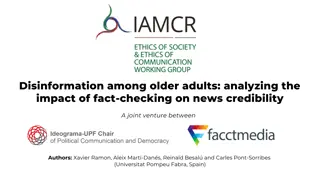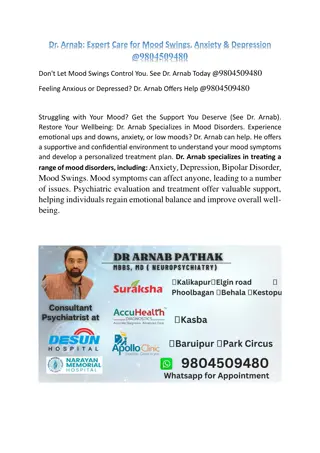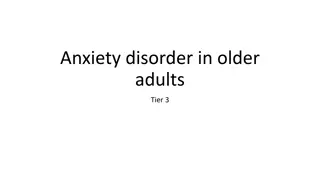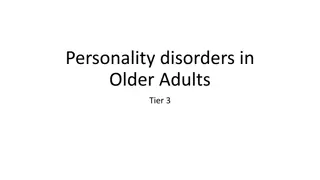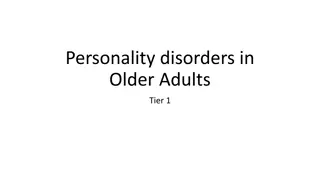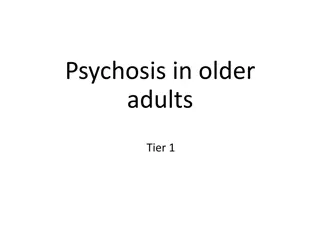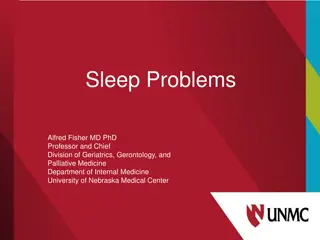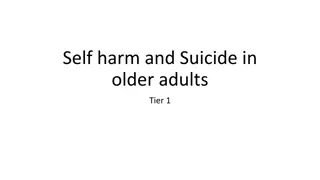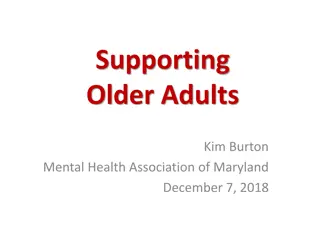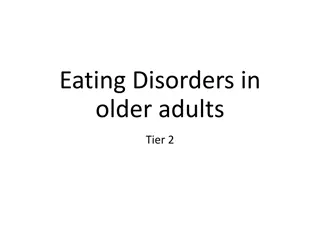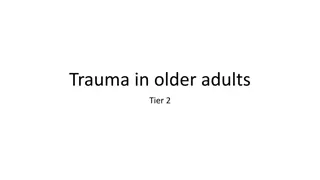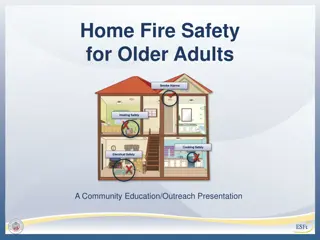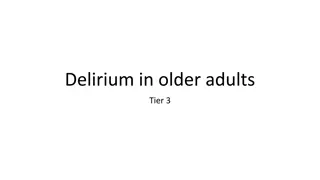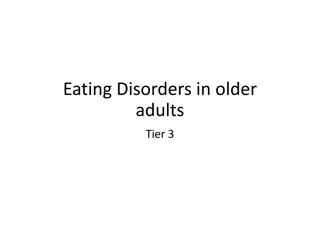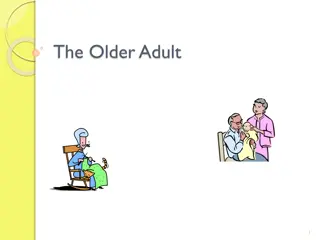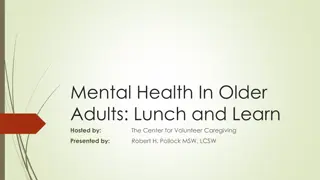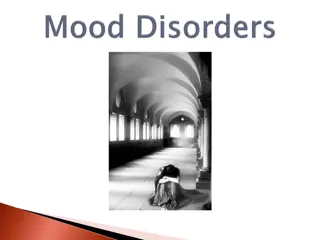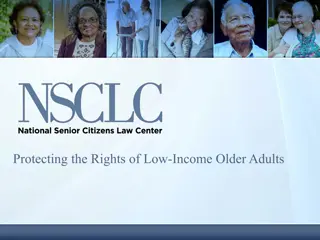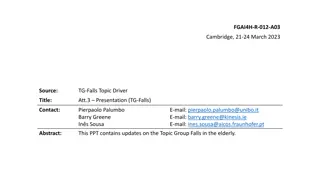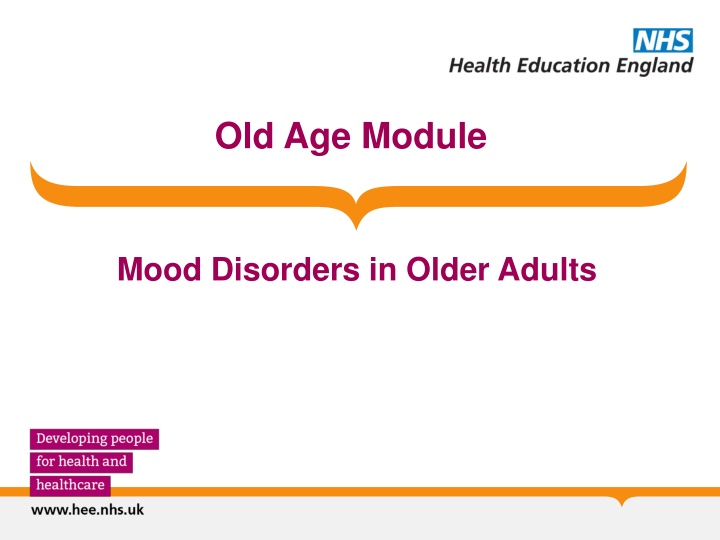
Mood Disorders in Older Adults: Epidemiology, Risk Factors, and Management
Covering the epidemiology, risk factors, and management of mood disorders in older adults, including the challenges in diagnosis, prevalence rates, impact of marital status, educational level, cognitive impairment, and social factors, as well as insights into treatment and suicide risks.
Download Presentation

Please find below an Image/Link to download the presentation.
The content on the website is provided AS IS for your information and personal use only. It may not be sold, licensed, or shared on other websites without obtaining consent from the author. If you encounter any issues during the download, it is possible that the publisher has removed the file from their server.
You are allowed to download the files provided on this website for personal or commercial use, subject to the condition that they are used lawfully. All files are the property of their respective owners.
The content on the website is provided AS IS for your information and personal use only. It may not be sold, licensed, or shared on other websites without obtaining consent from the author.
E N D
Presentation Transcript
Old Age Module Mood Disorders in Older Adults
Mood Disorders in Older Adults Aims and Objectives Understand the epidemiology, aetiology and the classification of mood disorders in the elderly. Understand how mood disorders present in the elderly (including psychotic features), the assessment process including neuroimaging and the use of rating scales and the principles of treatment/management including treatment resistance. Understand more about the risk of suicide in the elderly
Mood Disorders in Older Adults To achieve this Case Presentation Journal Club 555 Presentation Expert-Led Session MCQs Regional academic day for bipolar affective disorder in later life Please sign the register and complete the feedback
Old Age Module Expert Led Session Depression in Older Adults Dr Cathy Symonds Consultant Older Adult Psychiatrist Greater Manchester West MH Foundation Trust
Topics covered in this presentation Epidemiology of affective disorders and suicide Classifications/ presentations mood disorders in later life Neuroimaging Use of rating scales Treatment including in treatment resistant depression Suicide in elderly
Epidemiology Older adults - likely to report symptoms and co-morbid conditions make diagnosis difficult In 2011, point prevalence of DSM-IV major depression in those >75 in the UK was between 4.6% and 9.3% (Luppa, Sikorski, Luck, et al. 2012). Rates for sub-threshold depressive symptoms 4.5% to 37.4% (Meeks, Vahia, Lavretsky, et al.2011). Female incidence typically higher than male. Combined suicide rate for over 60s is 15 per 100,000 (Office for National Statistics, 2016)
Risk factors -Late life depression Divorced or widowed marital status Low educational level Poor self-rated health status Functional impairment Multi-domain Mild Cognitive Impairment (but beware of mistaking apathy with depression) Stressful life events and poor social network Carer role Bereavement Social isolation / loneliness (Luppa M et al 2012)
Personality attributes in late life depression Obsessional traits related to late life depression (Post 1972) Avoidant and dependent personalities more prone to late life depression (Abrams et al 1987) Cluster C personalities (Avoidant / Dependent / Obsessional Personalities) experience more dysfunction and likely to respond to treatment in late life depression (Morse and Robins -2005)
Classification Diagnostic Criteria (ICD-10/ DSM-V) ICD-10 at least 4 out of 10 and DSM-V 5 out of 9 symptoms ICD-10 at least 2 and DSM-V at least 1 of low mood, loss of interest/pleasure, loss of energy Two week history of consistent symptoms, sufficient severity, most of everyday. NICE guidelines use DSM-V Dysthymic disorder removed - now included under persistent mood disorder with chronic depression . Bereavement exclusion removed from major depressive disorder DSM-V
Key differences in presentations Core symptoms of major depression (low mood, anhedonia and loss of energy) are similar across the lifespan. Somatic concerns (hypochondriasis) may predominate, which can be challenging in older patients at risk of serious illness and/or with co-morbid physical problems. Hypochondriacal delusions are often prominent and easily overlooked. Psychotic symptoms in late-life depression are more common than at younger ages. Biological symptoms may be also be explained by co- morbid diseases eg chronic pain, making diagnosis more challenging
Hegeman, J.M., Kok, R.M., Van der Mast, R.C. and Giltay, E.J., 2012. Phenomenology of depression in older compared with younger adults: meta-analysis. The British Journal of Psychiatry, 200(4), pp.275-281.
Memory and mood Subjective memory complaints are: common sometimes hypochondriacal often labelled pseudodementia . The current preferred term for pseudodementia is depression-executive dysfunction syndrome (Alexopoulos et al 2012) Depressive cognitive biases, e.g. minimisation or selective abstraction can also cause clinical problems.
Late Life Depression- Pathophysiology Biogenic amines hypothesis Dopamine pathways CRF,TRH, GHRH, HPA axis abnormalities Immune and inflammatory responses-prolonged exposure to glucocorticoids. Structural brain changes: cortical atrophy, frontal lobe atrophy. White matter changes and small vessel disease (vascular depression) Other structural brain diseases can cause depressive symptoms (eg Parkinson s disease, stroke disease, PSP etc). Cerebral autosomal dominant arteriopathy with subcortical infarcts and leukoencephalopathy (CADASIL) initially presents with depression, as can most other dementias Myocardial infarctions linked to depression but unclear mechanism (SADHART study)
Vascular Depression Vascular depression hypothesis states that depression may be caused by ischaemic lesions especially in limbic/ prefrontal region (Alexopoulos 1997) Presentation Psychomotor retardation Less guilt Poorer insight Limited depressive symptoms More cognitive impairment and disability Fluency and naming impaired Homocysteine depression hypothesis. Elevated levels of homocysteine lead to cerebral vascular disease and neurotransmitter deficiency, which then cause depressed mood
Management - history Fullhistory, mental state, social history, drug and substance history The hidden addict (RCPsych report) reports that many older patients labelled as depressed actually have a primary substance misuse problem, usually alcohol but also prescribed medications plus street drugs. Prescribed medication (eg beta-blockers, steroids, tamoxifen) can cause depression Full medical history and focussed examination. Cognitive screening tool such as mini-ACE, MMSE, MoCA, ACE-III etc Consider frontal lobe tests
Management - investigations Suggested routine tests (in addition to a physical examination) for depression include: FBC U&Es; bone profile TFTs erythrocyte sedimentation rate (ESR) and/or C-reactive protein (CRP) (ESR can be raised in vasculitis with a minimally raised or normal CRP). If indicated: Gamma-GT B12 & folate LFTs autoantibody screen HIV antibodies Neuroimaging EEG.
Rating scales NICE recommends - objective and allow for progress over time (NICE, 2009) The Geriatric Depression Scale (GDS) has many formats and translations The Montgomery sberg Depression Rating Scale (MADRS) can guide treatment by helping to indicate severity. It is observer rated. The Cornell Scale for detecting depression in dementia uses observational data and is administered to a caregiver (Alexopoulos, Abrams, Young, et al. 1988). It takes a little longer (15 20 minutes) than the GDS, but is more specific. Mottram, Wilson, Ashworth et al (2002) showed that a score of 16 and above on the Hamilton Rating scalefor Depression (HDRS) or 21 on the MADRS were associated with a depressive disorder likely to benefit from medication. Other scales are available and a popular in MCQ questions!
Depression-Neuroimaging Areas of the brain implicated in late-life depression. Anterior cingulate cortex (ACC) small volume Orbitofrontal cortex (OFC) smaller volumes related to late life depression (includes limbic and basal ganglia areas) Hippocampus reduction in volume found in depressed elderly Severity of WM hyperintensities more in LOD compared to early onset depression suggesting varying aetiologies controversial?
Depression: functional neuroimaging Dorsal cingulate gyrus, middle and dorsolateral prefrontal cortex (DLPFC), insula, and superior temporal gyrus Hypoactive at rest during negative mood states Activity increases with SSRI treatment. Cortical-limbic network-the medial and inferior frontal cortex and basal ganglia Overactive at rest and during induction of negative mood states. Activity reduces with antidepressant treatment.
Treatment of late life depression MDT and patient centred approach Well informed patient - wishes and choices about treatment considered at all stages. Reviewing medication and physical illnesses contributing to presentation. Explaining treatment modalities in detail. Comprehensive Care plan provided to patients & carers Avoid excluding a cause (e.g. HIV, alcohol) or a treatment (e.g. psychotherapy) based on age alone.
Aim of treatment No different to younger adults Minimise risks Achieve remission in acute phase Assist in functioning to pre-morbid level Treatment of co-morbid physical health issues Maintain remission and prevent future relapses
Psychosocial interventions No evidence that psychotherapy less effective in cognitively intact later life patients Remains first line in mild-moderate depression as per NICE Less side effects than medication Less rigorous and/or behavioural approaches should be tried together with medication eg befriending schemes, reducing loneliness, day centres etc.
Psychosocial interventions Physical activity with antidepressants -more efficacious for MD compared to medication alone. (Mura G.2013),(Pereira D.S. 2013),(Tony G. 2013) Exercise shown to help with depression in long term care. (OPERA TRIAL-Underwood M 2011) Listening to music can help older people to reduce their depression level.(Chan M.F. 2012)
Pharmacological Intervention Consideration to be given to current physical health issues which can affect pharmaco-kinetic response Ensuring safe prescribing-noting drug interactions. Minimising polypharmacy. Monitor risk of delirium with medication (esp tricyclics) and hyponatraemia(SSRI s most likely to cause; mirtazapine, duloxetine & moclobemide least likely to cause) SSRIs upper GI bleed and spinal fractures
Pharmacological Intervention Sertraline does not effect QTc (SADHART) but reduce dose of citalopram in elderly (max 20mg; max dose of escitalopram 10mg) Sedatives increase risk of falls. Consider stopping co-prescribed medication that may cause depression (eg beta-blockers, opiates, etc )if safe to do so
Treatment phases Acute phase-initial phase with signs of improvement and remission usually weeks and tends to be longer in elderly Continuation phase-second phase to prevent relapse-usually months. At least 6 months after remission (NICE) Maintenance Treatment-prevention of future episodes usually years. At least 2 years after remission in recurrent depresion (NICE) Beware of under-treatingpatients e.g. patients stuck in partial remission, poor compliance, suboptimal dosing etc Have a step wise plan (see STAR*D study) and approach your treatment in a logical, holistic and evidence based way
Augmentation options SSRI with Lithium SSRI with Mirtazapine SSRI with Venlafaxine SSRI with TCA Mirtazapine with Venlafaxine
Augmentation strategies Antidepressants + antipsychotics - evidence limited in elderly. Reserve for psychotic depression, anxious or agitated depression. Acetylcholinesterase inhibitors- not shown to be efficacious in combination with anti-depressants. (McDermott C.L.2012) Lithium augmentation shown to be the most useful in systematic review in refractory depression.(Cooper et al 2011) Caution with lithium in elderly as lower end of treatment range is safer (0.4-0.6).
ECT Highly effective, safe and well tolerated (Geduldig, E.T., Kellner, C.H.2016) Effective in acute phase with high risk Rapidly acting to achieve remission (H. P. Spaans et al. (2015) Bilateral ECT more effective than unilateral treatment (Bjolseth T.M. 2015) Continuation/maintenance ECT an option for some
ECT More cognitive impairment evident with bilateral. Right unilateral ultra brief (RUL-UB) ECT with venlafaxine is relatively cognitively safe (Lisanby et al 2020) Prone to high relapse rate after initial remission. Continued use of antidepressant recommended to achieve long term remission. ECT remains a standard and vital treatment for their most seriously ill in the geriatric age group (Kellner etal 2015)
Social interventions Psychosocial interventions have a small but statistically significant effect in reducing depressive symptoms among older adults (Forsman AK 2011) A three-month outdoor activity intervention shown to improve mood among older people with severe mobility limitations. (Rantakokko etal 2015)
Prognosis Greater risk of relapse compared to young population. Poor prognosis indicated by Slow initial recovery Chronic depression Medical comorbidity Cerebrovascular disease Dementia Poor social support
Suicide Risk - Late Life Depression Among those who attempt suicide, elderly are the most likely to die. In adolescence, risk of attempted to completed suicides 200:1 Risk for the general population -from 8:1 to 33:1. Risk for elderly 4:1 4 times increased risk of self harm controlling for age, sex, and physical health than controls Higher score on Geriatric Depression Scale associated with early death by suicide
Suicide across the ages (Office for National Statistics, 2018)
Suicide and late life depression Increased suicide risk and non-suicide mortality. Elderly with suicidal thoughts -more likely to act on them and successfully commit suicide than their younger counterparts. Older age is significantly associated with more determined and planned self-destructive acts and with fewer warnings of suicidal intent. Most common methods firearms hanging self-poisoning falls from height
Take home messages Physical comorbidity and psychosocial stressors are key factors in later life depression, making diagnosis more challenging. Cognitive impairments, dementia and pseudo- dementia are important considerations. Treatment should be logical, holistic and stepwise. Suicide is declining in the elderly but is still a major preventable cause of death.
Old Age Module MCQs 1. The features suggestive of depression-executive dysfunction syndrome would include all except: A. There is a long history of memory impairment and difficulty with ADLs B. The patient complains of poor memory C. Assessment of cognitive function often results in 'don't know answers' D. The onset is fast E. There is often a history of depression or an identifiable precipitant
Old Age Module MCQs 1. The features suggestive of depression-executive dysfunction syndrome would include all except: A. There is a long history of memory impairment and difficulty with ADLs B. The patient complains of poor memory C. Assessment of cognitive function often results in 'don't know answers' D. The onset is fast E. There is often a history of depression or an identifiable precipitant
Old Age Module MCQs 2. An 84 year old lady presents with severe depression. She had a myocardial infarction 3 months ago and her QTc is 490ms. Which antidepressant would be the safest option? A. Sertraline B. Mirtazapine C. Paroxetine D. Citalopram E. Duloxetine
Old Age Module MCQs 2. An 84 year old lady presents with severe depression. She had a myocardial infarction 3 months ago and her QTc is 490ms. Which antidepressant would be the safest option? A. Sertraline B. Mirtazapine C. Paroxetine D. Citalopram E. Duloxetine
Old Age Module MCQs 3. An 87 year old man has lost his wife recently. Which of the following clinical features would most suggest that this was an abnormal grief reaction? A. Loss of sleep B. Loss of appetite C. Laying the dining table for the deceased at meal times D. Anxiety E. Suicidal ideation
Old Age Module MCQs 3. An 87 year old man has lost his wife recently. Which of the following clinical features would most suggest that this was an abnormal grief reaction? A. Loss of sleep B. Loss of appetite C. Laying the dining table for the deceased at meal times D. Anxiety E. Suicidal ideation
Old Age Module MCQs 4. Which is the not a feature of serotonin syndrome? A. Blurred vision B. Confusion C. Akathisia D. Elevated white cells E. Hypomimia
Old Age Module MCQs 4. Which is not a feature of serotonin syndrome? A. Blurred vision B. Confusion C. Akathisia D. Elevated white cells E. Hypomimia
Old Age Module MCQs 5. Which rating scale is most helpful in detecting depression in people with moderate dementia? A. Cornell B. MMSE C. GDS D. AMTS E. Hamilton Rating Scale
Old Age Module MCQs 5. Which rating scale is most helpful in detecting depression in people with moderate dementia? A. Cornell B. MMSE C. GDS D. AMTS E. Hamilton Rating Scale
Old Age Module MCQs 6. You have a patient on lithium with a consistently elevated blood pressure. What is your most appropriate action? A. Start amiloride B. Lithium must be stopped C. Start furosemide D. Start lisonopril E. Start candesartan
Old Age Module MCQs 6. You have a patient on lithium with a consistently elevated blood pressure. What is your most appropriate action? A. Start amiloride B. Lithium must be stopped C. Start furosemide D. Start lisonopril E. Start candesartan
Any Questions? Thank you If you have any feedback on the content of this presentation please email Dr Anthony Peter, Older Adult Module Lead Anthony.Peter@lancashirecare.nhs.uk

